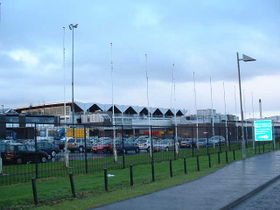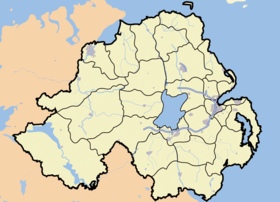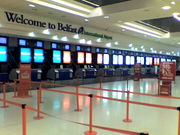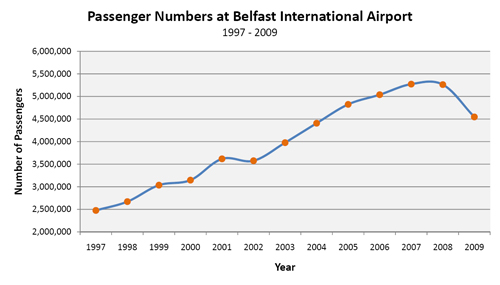Belfast International Airport
| Belfast International Airport Belfast/Aldergrove Airport |
|||
|---|---|---|---|
 |
|||
 |
|||
IATA: BFS – ICAO: EGAA
 Belfast
International Airport |
|||
| Summary | |||
| Airport type | Public | ||
| Owner | TBI plc | ||
| Operator | Belfast International Airport Ltd. | ||
| Serves | Belfast | ||
| Location | Aldergrove, County Antrim | ||
| Hub for |
|
||
| Elevation AMSL | 268 ft / 82 m | ||
| Website | |||
| Runways | |||
| Direction | Length | Surface | |
| m | ft | ||
| 07/25 | 2,780 | 9,121 | Asphalt |
| 17/35 | 1,891 | 6,204 | Asphalt |
| Statistics (2009) | |||
| Aircraft Movements | 68,813 | ||
| Passengers | 4,546,475 | ||
| Sources: UK AIP at NATS[1] Statistics from the UK Civil Aviation Authority[2] |
|||
Belfast International Airport (IATA: BFS, ICAO: EGAA) is an airport located 6 miles/11 kilometres from Antrim and 11.5 NM (21.3 km; 13.2 mi)[1] northwest of Belfast in Northern Ireland. It was formerly known and is still referred to as Aldergrove Airport, after the village of the same name lying immediately to the west of the airport. Belfast International shares its runways with the Royal Air Force base RAF Aldergrove, which otherwise has its own facilities.
Over 4.5 million passengers travelled through the airport in 2009, a 13.6% decline since 2008.[2] Belfast International is the busiest airport in Northern Ireland and the second busiest airport on the island of Ireland in terms of passenger numbers after Dublin Airport, and is followed by Cork and Shannon. It is the larger of two airports which serve Belfast; the other being Belfast-City.
The airport is owned by Abertis, the same company which owns Stockholm Skavsta and Cardiff Airport and is concessionary to Orlando Sanford International Airport and London Luton.
Belfast International has a CAA Public Use Aerodrome Licence (Number P798) that allows flights for the public transport of passengers or for flying instruction. The airport operates 24 hours a day, 365 days a year and is not subject to noise abatement procedures, significant environmental constraints or airspace limitations.
Contents |
History
1917-1945
The site for the airport was established in 1917 when it was selected to be a Royal Flying Corps training establishment during the First World War. The airport remained open at the end of the war for RAF activity.
Civil traffic began in 1922 when flights were conducted flying newspapers from Chester, although it was not until 1933 that a regular, sustained civil air service started. The flight was to Glasgow and was operated by Midland and Scottish Air Ferries. This was subsequently augmented by flights to the Isle of Man, Liverpool and Croydon, then London’s airport.
During the Second World War, Aldergrove remained an RAF base particularly for the Coastal Command. So that the airport could accommodate larger, long-range aircraft, a major works programme was undertaken to replace the four existing runways with two new long paved runways, thereby forming the basis of the layout that still exists at the airport today.
1946-1970
One of the outcomes of the wartime airfield construction programme was the building of Nutts Corner Airport, just 3 mi (4.8 km) from Aldergrove. On 1 December 1946, the new site replaced Belfast Harbour Airport (now George Best Belfast City Airport) as Northern Ireland’s civil airport, as the site at Sydenham was considered unsuitable.
By the 1950s civil air traffic had outstripped the facilities at Nutts Corner and, in addition, aircraft were being regularly diverted to Aldergrove because of adverse weather conditions. In July 1959 the decision was made to move civil flights to Aldergrove to take advantage of the large airfield and this took place in October 1963.
A new terminal and apron were built with the necessary passenger facilities and the complex was opened by Queen Elizabeth, The Queen Mother on 28 October 1963. In 1966 the first regular jet service to Gatwick started and in 1968 Aer Lingus and BOAC introduced scheduled services to New York City via Shannon and Prestwick respectively.
1971-1997
In 1971 Northern Ireland Airports Limited was formed to operate and develop the airport and its facilities. A major programme of airfield upgrades was undertaken resulting in improvements to runways, taxiways and the parking apron.
A new International Pier was built together with lounge facilities and car parks, while an additional apron was provided to separate the smaller general aviation aircraft from large commercial jets. In the meantime, British Airways launched the first Belfast to Heathrow shuttle service, and the first Boeing 747 operated from the airport on a charter service to Toronto via Shannon. The first scheduled service to a European city was started by NLM Cityhopper (now KLM Cityhopper) flying to Amsterdam.
In 1983 the airport, renamed Belfast International, was regularly accommodating the largest civil aircraft in service, and with the installation of new technology was capable of all weather operations. In 1985 passenger numbers reached 1.5 million and BMI went into competition with British Airways on the Heathrow service. Further developments to the terminal occurred throughout the late 1980s and early 1990s. A new Executive Aviation Terminal was opened in 1987 and the new cargo centre opened in 1991.
The airport was privatised in 1994. TBI became the new owners of the airport on 13 August 1996, by which time annual passenger numbers had reached 2.5 million.
1998 to date
In 1998 EasyJet started operations from the airport with flights to London Luton. Since then the airline has established a large base at Belfast International and a further eight domestic routes and 11 direct European scheduled routes have been added to the network, making the airline the largest user of the airport.[3]
In 2005 Continental Airlines launched the first ever direct scheduled service to Newark, and direct scheduled services were later introduced to Vancouver with Zoom Airlines but have now ceased following the carrier's demise in August 2008.
In December 2007 Aer Lingus opened a base at Belfast International, its third hub (and first outside the Republic of Ireland). By March 2008 three Airbus A320 aircraft were based at the airport serving nine Aer Lingus routes from Belfast, and the airline has restored the link between Belfast International and London Heathrow Airport which was abandoned by British Airways.[4]
Flyglobespan previously operated summer seasonal services to Orlando Sanford International Airport and John C. Munro Hamilton International Airport. These routes ceased following the carrier's demise in December 2009.
Despite these additional flights, passengers at Belfast International did not rise beyond 6 million in 2008 as some had predicted[5] but in fact fell by 10,000 passengers to 5.2 million.
Work has been completed within the airport to move the 'Central Search' area from its previous location,this is part of a bigger plan to increase the area for the main departure Lounge.[6] In addition,as of June 2010 the airport's new drop off zone has been completed and implimented at the front of the complex. The airport has one jetway/airbridge that allows speedy boarding. It is used on the Newark Service as well as other charter, high density services to the mainland Europe. Terminal One is large and accommodates most aircraft. The terminal serves all destinations
Airlines and destinations


Note: † denotes charter operators and their destinations
| Airlines | Destinations |
|---|---|
| Aer Lingus | Alicante [seasonal], Barcelona, Faro [seasonal], Lanzarote, London-Heathrow, Málaga, Rome-Fiumicino [seasonal], Tenerife-South |
| Air Europa † | Palma de Mallorca [seasonal] |
| Air Méditerranée | Lourdes [seasonal] |
| Austrian Airlines
operated by Tyrolean Airways †
|
Innsbruck [seasonal] |
| BH Air † | Burgas [seasonal], Sofia [seasonal] |
| Bmibaby | Cardiff [resumes 31 October], Birmingham, East Midlands, Manchester |
| Bulgaria Air † | Burgas [seasonal], Plovdiv [begins 19 December; seasonal] Sofia [seasonal], Varna [begins 19 December; seasonal] |
| Continental Airlines | Newark |
| Dubrovnik Airline † | Dubrovnik [seasonal], Split [seasonal] |
| EasyJet | Alicante, Amsterdam, Barcelona, Bristol, Edinburgh, Faro, Geneva [seasonal], Glasgow-International, Ibiza [seasonal], Kraków, Liverpool, London-Gatwick, London-Stansted, Málaga, Malta [begins 15 February 2011], Newcastle upon Tyne, Nice [seasonal], Palma de Mallorca [seasonal], Paris-Charles de Gaulle |
| Easyjet † | Zürich [begins 19 December; seasonal] |
| Eurocypria Airlines † | Heraklion [seasonal], Larnaca [seasonal], Paphos [seasonal] |
| Freebird Airlines † | Dalaman [seasonal] |
| Iberworld † | Faro [seasonal] |
| Jet2.com | Blackpool [seasonal], Dubrovnik [seasonal], Geneva [begins 20 December; seasonal], Ibiza [seasonal], Jersey [seasonal], Leeds/Bradford, Lourdes, Minorca [seasonal], Murcia [seasonal], Newquay [seasonal], Palma de Mallorca [seasonal], Pisa [seasonal], Tenerife-South [seasonal], Toulouse [seasonal] |
| Jet2.com † | Turin, Venice, Vienna [begins 4 December], Verona-Brescia |
| Manx2 | Galway, Isle of Man |
| Nouvelair † | Monastir [seasonal] |
| Onur Air † | Bodrum [seasonal], Dalaman [seasonal], İzmir [seasonal] |
| Travel Service (Czech Republic) † | Corfu [seasonal], Faro [seasonal] , Fuerteventura [seasonal], Ibiza [seasonal], Lanzarote [seasonal], Las Palmas de Gran Canaria [seasonal], Málaga [seasonal], Palma de Mallorca [seasonal], Reus [seasonal], Rhodes [seasonal], Tenerife South |
| Thomas Cook Airlines † | Alicante, Antalya [seasonal], Bodrum [seasonal], Corfu [seasonal], Dalaman, Enfidha [begins 4 May 2011], Fuerteventura, Heraklion [seasonal], Ibiza [seasonal], Izmir [seasonal], Lanzarote, Larnaca [seasonal], Las Palmas de Gran Canaria, Monastir, Palma de Mallorca [seasonal], Reus [seasonal], Sharm el-Sheikh, Tenerife-South, Toulouse [seasonal], Verona [seasonal] |
| Thomson Airways | Alicante [ends 25 October], Bodrum [seasonal], Burgas [seasonal], Dalaman [seasonal], Faro [seasonal], Ibiza [seasonal], Lanzarote [seasonal], Las Palmas de Gran Canaria [seasonal], Málaga [seasonal], Palma de Mallorca [seasonal], Reus, Rovaniemi [begins 10 December]. Sharm el-Sheikh [begins 4 May 2011], Tenerife-South [seasonal] |
| Viking Airlines † | Corfu [seasonal], Dalaman [seasonal], Rhodes [seasonal] |
| Viking Hellas † | Heraklion [seasonal] |
Cargo
Belfast International Airport is one of the most important regional airfreight centres in the UK, handling 48,000 tonnes (47,000 LT; 53,000 ST) of air cargo in 2008.[7] BIA plays host to a long-established nightly Royal Mail operation. The major cargo operators are:
| Airlines | Destinations |
|---|---|
| DHL Express | East Midlands, London-Luton |
| DHL Express
operated by Atlantic Airlines
|
Coventry |
| Jet2.com | East Midlands |
| Maersk | London-Stansted |
| Titan Airways | Birmingham |
| TNT Airways | East Midlands, |
Statistics

Nearly 5.3 million passengers used Belfast International in 2007, the highest total in the airport's history, with total passenger numbers remaining relatively static during 2008 but declining sharply in 2009 to 4.5 million.[2] The airport is the busiest in Northern Ireland, having experienced steady growth in passenger numbers, aircraft movements and freight throughput over most of the last decade. Between 1997 and 2009 passenger numbers have increased by an average of 7.0% annually. Belfast International was the 13th busiest airport in the UK by passenger traffic in 2009, but the large freight volumes handled made it the 6th busiest freight airport in the UK during the period.[2]
|
 |
|||||||||||||||||||||||||||||||||||||||||||||||||||||||||||||
| Rank | Airport | Passengers handled in 2009 | Passengers handled in 2008 | Percentage Change | Airlines Served (2009) |
|---|---|---|---|---|---|
| 1 | 166,017 | 187,529 | Aer Lingus, easyJet, Thomson | ||
| 2 | 144,345 | 128,537 | easyJet, Aer Lingus | ||
| 3 | 125,419 | 128,091 | Aer Lingus, BMI, easyJet, Iberworld, Thomson, Thomas Cook | ||
| 4 | 124,539 | 150,828 | Air Europa, easyJet, Jet2, Thomson, Thomas Cook | ||
| 5 | 99,794 | 99,714 | Continental Airlines | ||
| 6 | 95,665 | 122,121 | Aer Lingus, easyJet | ||
| 7 | 91,031 | 138,669 | easyJet | ||
| 8 | 86,864 | 97,098 | bmi, easyJet, Thomson, Thomas Cook | ||
| 9 | 84,993 | 66,545 | Aer Lingus, BMI, Thomson, Thomas Cook | ||
| 10 | 57,196 | 93,725 | Aer Lingus*, Jet2*, bmi, Thomson, Thomas Cook | ||
| 11 | 47,911 | 45,545 | BMI, Onur Air, Thomas Cook, Thomson | ||
| 12 | 42,857 | 36,545 | Aer Lingus | ||
| 13 | 41,085 | 50,783 | easyJet | ||
| 14 | 40,108 | 54,783 | easyJet | ||
| 15 | 35,980 | 44,132 | Jet2 | ||
| 16 | 31,419 | 4,687 | Aer Lingus | ||
| 17 | 28,938 | 36,786 | Onur Air, Thomas Cook, Thomson | ||
| 18 | 25,228 | 39,649 | Thomas Cook, Thomson | ||
| 19 | 24,049 | 27,720 | easyJet, Jet2, Thomas Cook, Thomson | ||
| 20 | 23,875 | 27,276 | Flyglobspan (now defuncted), Thomas Cook |
- = Tenerife-South Aer Lingus and Jet2 services began in late 2009
| Rank | Airport | Passengers handled in 2009 | Passengers handled in 2008 | Percentage Change | Airlines Served (2009) |
|---|---|---|---|---|---|
| 1 | Liverpool John Lennon Airport | 397,052 | 394,569 | easyJet | |
| 2 | London Gatwick Airport | 309,976 | 347,377 | easyJet | |
| 3 | London Stansted Airport | 293,077 | 313,111 | easyJet | |
| 4 | London Heathrow Airport | 266,819 | 258,033 | Aer Lingus | |
| 5 | London Luton Airport | 246,905 | 263,238 | easyJet | |
| 6 | Edinburgh Airport | 232,121 | 236,927 | easyJet | |
| 7 | Glasgow International Airport | 223,844 | 219,623 | easyJet | |
| 8 | Newcastle International Airport | 192,673 | 205,180 | easyJet | |
| 9 | Bristol Airport | 163,459 | 211,923 | easyJet | |
| 10 | Birmingham International Airport | 130,139 | 155,920 | Bmibaby |
| July 2010 | July 2009 | Percentage change | |
|---|---|---|---|
| Passengers handled | 494,265 | 556,830 |
Transport links
Road
Travellers by car from Belfast reach the airport via the M2 motorway.
Bus
Translink operates a 24 hour bus service to the airport from their Europa Buscentre, in the centre of Belfast. The airport can be reached from Derry and the northwest by the Airporter.
Train
The nearest railway station is the Antrim railway station which is 10 km (6.2 mi) from the airport in Antrim, and is serviced by a bus link called the Antrim Airlink (109 A). There are connections to Belfast, Lisburn and Derry. Trains to and from Dublin are via Belfast Central railway station, which has its own Airbus stop. A new station serving the airport could one day be constructed on the mothballed Lisburn-Antrim railway line as set out in the airport master plan. This line remains in serviceable condition and passes close to the airport terminal.
Future plans
In September 2006, Belfast International Airport published their master plan[10] for the next 25 years. The master plan predicts that passenger numbers will increase to between 6 million passengers per annum (mppa) and 7.5 mppa by 2015 and to 12 mppa by 2030. Cargo throughput at BIA could reach as high as 82,000 t (81,000 LT; 90,000 ST) by 2015, and 148,000 t (146,000 LT; 163,000 ST) by 2030. To accommodate this growth a number upgrades have been suggested, some of these are listed below.
2006-2015
- Extension of check-in hall
- Extension and reconfiguration of domestic baggage reclaim
- Construction of a new South Pier including departure lounges
- Extension of West Pier
- Construction of multi-storey car park and high level link to terminal
- Expansion of cargo/freight handling facilities located on western boundaries
2015-2030
- New three storey central core linking to existing and recently developed areas.
- A passenger rail connection to the airport
- Enhanced highway links between airport and M2 motorway and improved public transport direct to all parts of Northern Ireland.
- Demolition of the old terminal (replacement in operation)
Accidents and incidents
- On 24 March 1996, Vickers Viscount G-OPFE of British World Airways was damaged beyond economic repair when it made a wheels-up landing.[11]
- On 23 December 1997, a Maersk Air, Boeing 737 aircraft operated by British Airways and with 63 passengers and 6 crew on board was forced to return to the airport after a major failure in the starboard engine. The pilot was forced to declare an emergency and the aircraft thereafter returned to the airport safely on one engine. It was later found that an engine seal had failed causing the catastrophic failure of the starboard engine and slight damage to the engine cowling and under wing surface. The subsequent investigation uncovered design and manufacturing defects with the seals and led to the incorporation of new design seals in all future engines.[12]
References
- ↑ 1.0 1.1 Belfast/Aldergrove - EGAA
- ↑ 2.0 2.1 2.2 2.3 2.4 2.5 2.6 2.7 2.8 UK Airport Statistics: 2009 - annual
- ↑ "easyJet Route Map". easyJet. http://www.easyjet.com/EN/routemap.
- ↑ "Belfast International Airport lands Aer Lingus". Belfast International Airport Press Office. http://www.belfastairport.com/en/news.asp?id=335. Retrieved 2007-12-06.
- ↑ "We have lift-off!". Belfast Telegraph. http://www.belfasttelegraph.co.uk/business/article3239514.ece. Retrieved 2007-12-10.
- ↑ Belfastairport.com
- ↑ "Key facts". Belfast International Airport. http://www.belfastairport.com/en/content/8/156/key-facts.html. Retrieved 2009-09-01.
- ↑ Number of Movements represents total air transport takeoffs and landings during that year.
- ↑ UK Airport Statistics
- ↑ Master Plan
- ↑ "Accident description". Aviation Safety Network. http://aviation-safety.net/database/record.php?id=19960324-0. Retrieved 9 October 2009.
- ↑ AAIB.gov.uk
External links
|
||||||||||||||||||||
|
||||||||||||||
